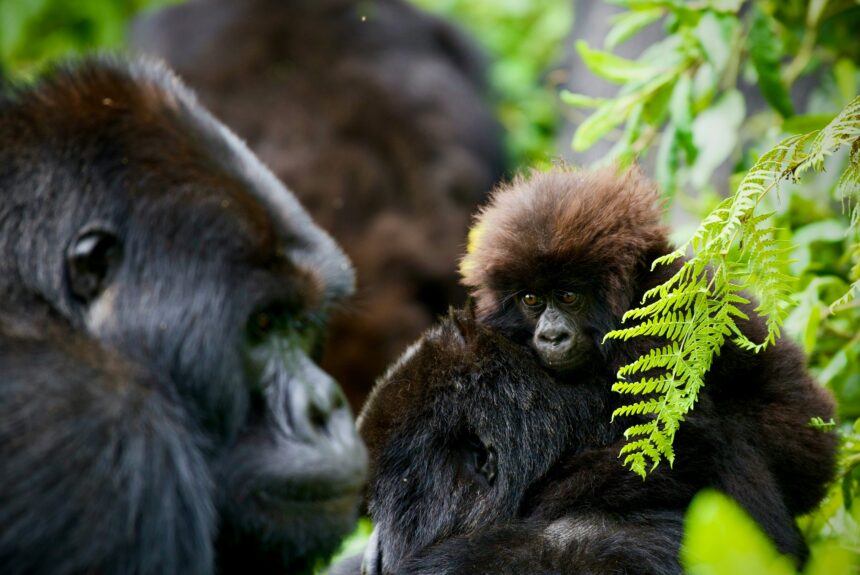As we venture deeper into the forests that mountain and lowland gorillas call home, we must remember that we are guests in these fragile ecosystems. The rise in eco-tourism has allowed adventurers to experience the wild’s beauty while minimizing their environmental impact. By adopting eco-friendly practices, we can help protect these incredible animals, the local communities, and the biodiversity of their habitats.
This guide will provide practical tips for ensuring your gorilla trek is as sustainable as thrilling. From choosing responsible tour operators to reducing your waste and carbon footprint, you’ll learn how small actions can make a big difference in preserving the environment. Join us in exploring how to make your journey one that respects nature, conserves resources, and positively impacts the areas you visit. After all, the future of gorilla conservation depends on how we trek today.
1. Choose a Responsible Tour Operator
The cornerstone of an eco-friendly gorilla trekking experience is selecting the right tour operator. While many companies offer gorilla safari packages, not all adhere to sustainable practices. A responsible operator ensures that your trek leaves as little impact as possible on the delicate ecosystem while contributing to the long-term protection of gorillas and their natural habitats.
Start by researching operators with strong ties to conservation organizations officially recognized by wildlife authorities. Operators affiliated with groups like the Uganda Wildlife Authority (UWA) or the Rwanda Development Board (RDB) are generally more committed to upholding conservation standards. These partnerships ensure that your trekking fees are reinvested into park maintenance, gorilla protection initiatives, and local community development projects that provide alternative livelihoods to those living near the parks.
Additionally, look for certifications like those from the Global Sustainable Tourism Council (GSTC) or Rainforest Alliance, which indicate that the company meets international standards for sustainable tourism. These certifications usually require operators to minimize environmental impact, respect local cultures, and contribute to biodiversity conservation.
Considering how the tour operator engages with local communities is equally important. Ethical operators employ local guides and staff, providing them fair wages and training opportunities. This fosters goodwill between the tourism industry and regional populations and empowers communities to participate actively in conservation efforts. Sustainable operators often invest directly in local development projects—like schools, healthcare, and clean water infrastructure—further supporting the areas surrounding gorilla habitats.
When choosing a tour operator, ask specific questions about their environmental policies:
- How do they minimize their environmental footprint?
- Do they limit group sizes to reduce habitat disruption?
- What steps do they take to educate trekkers about conservation?
- How do they support local conservation efforts and communities?
2. Respect Gorilla Habitats: Follow Park Guidelines
Maintain the Required Distance
One of the most essential rules when tracking gorillas is maintaining a minimum distance of at least 7 meters (about 23 feet) from them. This rule prevents the transmission of human diseases, which significantly threaten their survival. Because gorillas share approximately 98% of their DNA with humans, they are highly vulnerable to our illnesses, especially respiratory infections, which can be fatal. By keeping this distance, you respect the wildlife and play a direct role in protecting these endangered animals.
Limit Time with the Gorillas
Another crucial guideline is the one-hour time limit for trekkers to observe a gorilla family. While it may seem brief, this rule is vital for the animal’s well-being. Prolonged exposure to humans can stress the gorillas, leading to altered behavior or disruption of their daily routines, such as feeding, grooming, or caring for their young. Limiting your time ensures that the gorillas remain undisturbed and continue their natural activities without human interference.
Listen to Your Guides and Rangers
Park rangers and guides are trained professionals with deep knowledge of gorilla behavior and habitat management. Their instructions are essential for your safety and the welfare of the gorillas. Ignoring their guidance can lead to unnecessary risks, such as disturbing the animals or damaging the environment. Always follow their lead and respect their knowledge—they are vital to ensuring your gorilla trek remains safe and sustainable.
3. Minimize Your Carbon Footprint During Travel
Choose Eco-Friendly Transportation Options
The journey to your gorilla trekking destination is often the most carbon-intensive part, especially if it involves long-distance flights. While air travel is often unavoidable, there are ways to mitigate its environmental impact. One option is to choose airlines that offer carbon offset programs, allowing you to compensate for your flight’s emissions by investing in environmental projects like reforestation or renewable energy. Many airlines now provide this option when booking, but you can also purchase offsets through independent organizations dedicated to reducing global carbon footprints.
Once you arrive in the destination country, opt for eco-friendly transportation options. Whenever possible, use public transportation or shared vehicles to minimize fuel consumption. Some operators in countries like Uganda and Rwanda offer hybrid transport options to the trekking areas. These vehicles significantly reduce carbon emissions compared to traditional gas-powered cars. Additionally, consider choosing smaller group tours or carpooling with other travelers to minimize the environmental impact further.
Stay Longer in One Location
Another effective way to reduce your carbon footprint is to minimize unnecessary travel between destinations. Instead of hopping between multiple locations over a short period, consider staying in one area longer. This reduces the need for additional transportation, which in turn lowers emissions. Staying longer in a specific region immerses yourself more deeply in the local culture and environment, offering a more meaningful gorilla safari experience.
For example, consider booking an itinerary incorporating these activities within the same region instead of planning separate trips to see mountain gorillas, chimpanzees, and other wildlife. The protected areas that protect the mountain gorillas offer opportunities to see a variety of species in one location, allowing you to experience more without increasing your travel footprint.
Support Eco-Friendly Accommodations
Where you stay during your trip also significantly affects your carbon footprint. Many lodges and accommodations near Bwindi Impenetrable Forest and Volcanoes National Park Rwanda are adopting eco-conscious practices to reduce their environmental impact. Look for lodges that use renewable energy sources, such as solar power, and employ water conservation practices like rainwater harvesting or low-flow plumbing fixtures. Some lodges also use energy-efficient lighting and heating systems to reduce their carbon emissions further.
In addition, some eco-friendly accommodations are committed to minimizing waste, often offering recycling programs, composting organic waste, and reducing single-use plastics. Choosing accommodations focusing on sustainability ensures that your overall environmental impact is minimized while supporting businesses prioritizing conservation.
4. Pack Light and Eco-Friendly Gear
Opt for Reusable and Sustainable Items
Packing eco-friendly gear is one of the simplest yet most impactful ways to reduce your environmental footprint on a gorilla trek. Start by selecting reusable items to replace single-use plastics, a significant pollution source in fragile ecosystems. For example, carry a reusable water bottle with a built-in filter to stay hydrated without relying on plastic bottles. Most lodges near Uganda’s Bwindi and Rwanda’s Volcanoes Park provide safe drinking water, so you can refill your bottle rather than purchasing disposable water containers.
Other sustainable essentials include reusable food containers and utensils if you plan to bring snacks or meals on your trek. This helps eliminate waste and keeps plastic out of the forest environment. In addition, bring a reusable bag for any purchases or supplies you may carry, reducing the need for plastic shopping bags.
Choose Environmentally Friendly Clothing and Gear
Eco-conscious travelers should also consider the type of clothing and trekking gear they bring. Invest in items made from sustainable materials, such as organic cotton, bamboo, or recycled polyester. These fabrics require fewer resources and have less environmental impact than traditional synthetics. Additionally, choose high-quality gear that will last for many adventures rather than fast-fashion products that wear out quickly and contribute to waste.
When it comes to trekking essentials, consider purchasing biodegradable soap and toiletries, ensuring that any runoff from washing won’t harm the local environment. Many trekking companies or lodges offer eco-friendly toiletries. Still, bringing your biodegradable soap, shampoo, and toothpaste is always a good idea to ensure you’re leaving no harmful chemicals behind.
Pack Light to Reduce Your Impact
Packing light has multiple benefits for your comfort and the environment. A lighter load requires less energy to transport—whether traveling by air, vehicle or on foot—resulting in a smaller carbon footprint. Additionally, carrying only essential gear helps prevent the overuse of local resources, such as fuel and porters’ energy, during your trek.
When packing for a gorilla trek, focus on multi-purpose gear to minimize the number of items you bring. For instance, a lightweight, waterproof jacket can serve as rain protection and an extra layer in colder weather. Similarly, pack clothing that can be worn in layers, allowing you to adjust to changing temperatures without bringing separate outfits for every condition. Remember that most lodges offer laundry services, so there’s no need to overpack.
Leave No Trace
Be mindful of the Leave No Trace principles as part of your commitment to eco-friendly trekking. Everything you bring into the forest, including trash, food wrappers, and used toiletries, should be left with you. Getting a small waste bag with you is essential to collect any items you use along the trek. Even biodegradable items like fruit peels can disrupt local ecosystems or attract wildlife to unnatural feeding behaviors.
5. Support Local Communities
One of the most effective ways to ensure your gorilla trek has a positive environmental and social impact is by directly supporting local communities. Gorilla trekking often occurs in remote areas where local populations depend heavily on eco-tourism for their livelihoods. When you engage with these communities in a responsible and supportive way, you help create a sustainable system that benefits both people and wildlife.
Choosing to stay in locally owned accommodations, dine at local restaurants, and purchase handmade crafts or souvenirs from community vendors are small but significant actions. These activities help inject money into the local economy, creating more jobs and reducing reliance on harmful practices like poaching or deforestation. When communities benefit economically from eco-tourism, they are more motivated to protect the gorillas and their habitats, creating a win-win scenario for conservation and community development.
Many tour operators partner with local cooperatives or community-based tourism initiatives that offer unique experiences, such as cultural performances or village tours. Participating in these activities gives you insight into the local people’s traditions, customs, and daily life while supporting their efforts to preserve their cultural heritage. However, be mindful of choosing respectful and ethical experiences, ensuring that any community interaction is done with full consent and that the benefits go directly to the people involved.
Another essential aspect of supporting local communities is ensuring local guides and trackers lead your trek. These professionals have in-depth knowledge of the terrain and wildlife, and hiring locally also provides employment and empowers individuals to take an active role in conservation efforts. Many guides are former poachers who have transitioned into conservation roles, uniquely suited to protect gorillas and educate visitors about the delicate balance between human needs and wildlife protection.
Additionally, consider directly contributing to community-based conservation projects or local development initiatives. Many lodges and trekking companies partner with nonprofit organizations to improve infrastructure, education, and healthcare in gorilla trekking regions. Donating to these causes, whether through financial contributions or volunteering, helps ensure that the benefits of eco-tourism reach beyond the immediate trekking experience.
Conclusion: Leave a legacy by making Your Trek Count
Every small action you take as a traveler can have a lasting impact on the conservation of gorillas. Whether through financial contributions, raising awareness, or supporting local projects, your commitment to conservation can extend far beyond the boundaries of your trek. Many trekkers leave with a deep appreciation for these incredible animals and a desire to do more to protect them. Consider turning that passion into action by advocating for gorilla conservation, sharing your experiences with others, and supporting efforts to keep these vulnerable species safe.
Image: Unsplash, Jeremy Stewardson


